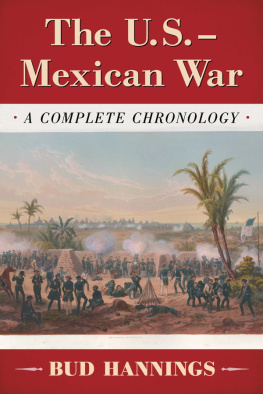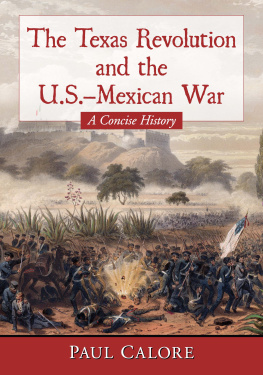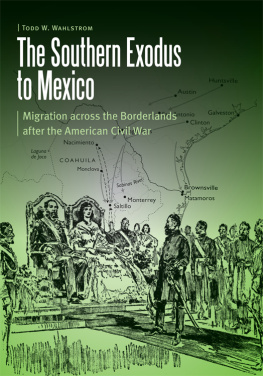A LIFE CROSSING BORDERS
Memoir of a Mexican-American Confederate Las memorias de un mexicoamericano en la Confederacin

Recovering the U.S. Hispanic Literary Heritage
Board of Editorial Advisors
Jos F. Aranda, Jr.
Rice University
Gabriela Baeza Ventura
University of Houston
Alejandra Balestra
Independent Scholar
Rose Marie Beebee
Santa Clara University
Aviva Ben-Ur
University of Massachusetts, Amherst
Antonia Castaeda
St. Marys University
Rodolfo J. Cortina
University of Houston
Kenya C. Dworkin y Mndez
Carnegie Mellon University
Jos B. Fernndez
University of Central Florida
Juan Flores
Hunter College of CUNY
Erlinda Gonzales-Berry
Oregon State University
Jos A. Gurpegui
Universidad de Alcal
Laura Gutirrez-Witt
University of Texas at Austin
Jos M. Irizarry Rodrguez
University of Puerto Rico, Mayagez
Donna M. Kabalen de Bichara
Tecnolgico de Monterrey
Luis Leal
University of California at Santa Barbara
Clara Lomas
The Colorado College
Francisco A. Lomel
University of California at Santa Barbara
Blanca Lpez de Mariscal
Tecnolgico de Monterrey
Agnes Lugo-Ortiz
University of Chicago
A. Gabriel Melndez
University of New Mexico
Genaro Padilla
University of California at Berkeley
Raymund Paredes
Commision of Higher Education, State of Texas
Nlida Prez
Hunter College of CUNY
Gerald Poyo
St. Marys University
Barbara O. Reyes
University of New Mexico
Antonio Saborit
Instituto Nacional de Antropologa e Historia
Rosaura Snchez
University of California at San Diego
Virginia Snchez Korrol
Brooklyn College of CUNY
Charles Tatum
University of Arizona
Silvio Torres-Saillant
Syracuse University
Roberto Trujillo
Stanford University
Toms Ybarra-Frausto
Independent Scholar
A LIFE CROSSING BORDERS
Memoir of a Mexican-American Confederate
Las memorias de un mexicoamericano en la Confederacin
REV. SANTIAGO TAFOLLA
EDITED BY CARMEN TAFOLLA AND LAURA TAFOLLA
ENGLISH TRANSLATION BY FIDEL L. TAFOLLA
Recovering the U.S. Hispanic Literary Heritage

A Life Crossing Borders : Memoir of a Mexican-American Confederate / Las memorias de un mexicoamericano en la Confederacin is made possible through grants from the City of Houston through the Houston Arts Alliance and by the Exemplar Program, a program of Americans for the Arts in collaboration with the LarsonAllen Public Services Group, funded by the Ford Foundation.
Recovering the past, creating the future
Arte Pblico Press
University of Houston
452 Cullen Performance Hall
Houston, Texas 77204-2004
Cover design by Pilar Espino
Tafolla, Santiago, 1837-1911.
A Life Crossing Borders : Memoir of a Mexican-American Confederate / by Santiago Tafolla ; edited by Carmen Tafolla and Laura Tafolla; English translation by Fidel Tafolla.
p. cm.
Published as part of the Recovering the U.S. Hispanic Literary Heritage Project seriesIntro.
Translation of original handwritten, Spanish-language manuscript entitled Memorias de un mexicoamericano en la Confederacin; includes Spanish transcription and English translation.
Includes bibliographical references.
ISBN 978-1-55885-597-7 (alk. paper)
1. Tafolla, Santiago, 1837-1911. 2. Mexican Americans Biography. 3. Mexican AmericansEthnic identity. 4. Confederate States of America. ArmyBiography. 5. United StatesHistoryCivil War, 1861-1865Personal narratives, Mexican American. 6. New MexicoHistory1848Biography. 7. Santa Fe (N.M.)Biography. 8. Circuit ridersUnited StatesBiography. 9. RanchersSouthwest, NewBiography. 10. Justices of the peaceTexasBiography. I. Tafolla, Carmen, 1951- II. Tafolla, Laura. III. Tafolla, Fidel L. IV. Title.
E184.M5T35 2009
978.9'04092dc22
[B]
2009038008
CIP
 The paper used in this publication meets the requirements of the American National Standard for Information SciencesPermanence of Paper for Printed Library Materials, ANSI Z39.48-1984.
The paper used in this publication meets the requirements of the American National Standard for Information SciencesPermanence of Paper for Printed Library Materials, ANSI Z39.48-1984.
2010 by Carmen Tafolla and Laura Tafolla
Printed in the United States of America
10 11 12 13 14 15 16 10 9 8 7 6 5 4 3 2 1
To Santiago
who dared to go searching for something better,
and to our parents,
who taught us to respect our heritage
as well as our dreams.
C.T. & L.T.

TABLE OF CONTENTS

Santiago with 7 of his sons. Seated left to right are: J.J. Mercado, Jr., Santiago Tafolla, and Pete Tafolla. Standing are Santiagos youngest sons: Ernesto, Santiago Jr., Gabriel, Mariano F., Lott.

INTRODUCTION
C rossing borders is a daunting task. It requires the changing of rules, the changing of focus, and often, the changing of attitudes. It may also require the revamping of previously held beliefs. Santiago Tafolla, in the year 1908, at the age of seventy-one, took pencil to primary tablet and wrote about the borders, and the changes, of his life. This book carries the Spanish transcription, and the English translation, of that account and documents the life story of an individual who throughout his life crossed many bordersnational, political, religious, cultural and personal.
Born in Santa Fe, New Mexico, Republic of Mexico, in 1837, to a father who had lived and served at the same presidio when it was under the flag of Spain, and then under the red, white and green of the newly born Repblica de Mxico, he would himself see and live through many changes of flag, traveling from the newly acquired-by-war U.S. Territory of New Mexico to the United States proper, from Missouri to New York, and from Pennsylvania Avenue in Washington D.C., to the plantations of Georgia. He would see Maryland, Kentucky, Ohio, Texas, and the Indian Territory of Oklahoma as part of the U.S. Army Second Cavalry, and subsequently as part of the Confederate Army. He would live in Mexico, in the state of Coahuila, as an expatriate for a year, then return to the United States as a rancher, a fur trader, a justice of the peace and finally, a Methodist preacher.
A personal witness to a time period of continually shifting borders, identities and allegiances, this is a powerful autobiography, challenging the stereotypes and reclaiming the history of Latinos in the United States. A valuable and fascinating work on its own, the historical links and substantiating documents that accompany it make it an even more important source for the understanding of our history and culture on this continent. Beyond the casual references to Robert E. Lee, Jefferson Davis, Gen. Juan Cortina, Congressman Jos Gallegos and Major Earl Van Dorn, the personal observation of lesser-known events, attitudes, biases and cultural conflicts adds to our understanding of such diverse situations as White Confederate gangs threatening to lynch their
Next page






 The paper used in this publication meets the requirements of the American National Standard for Information SciencesPermanence of Paper for Printed Library Materials, ANSI Z39.48-1984.
The paper used in this publication meets the requirements of the American National Standard for Information SciencesPermanence of Paper for Printed Library Materials, ANSI Z39.48-1984.
